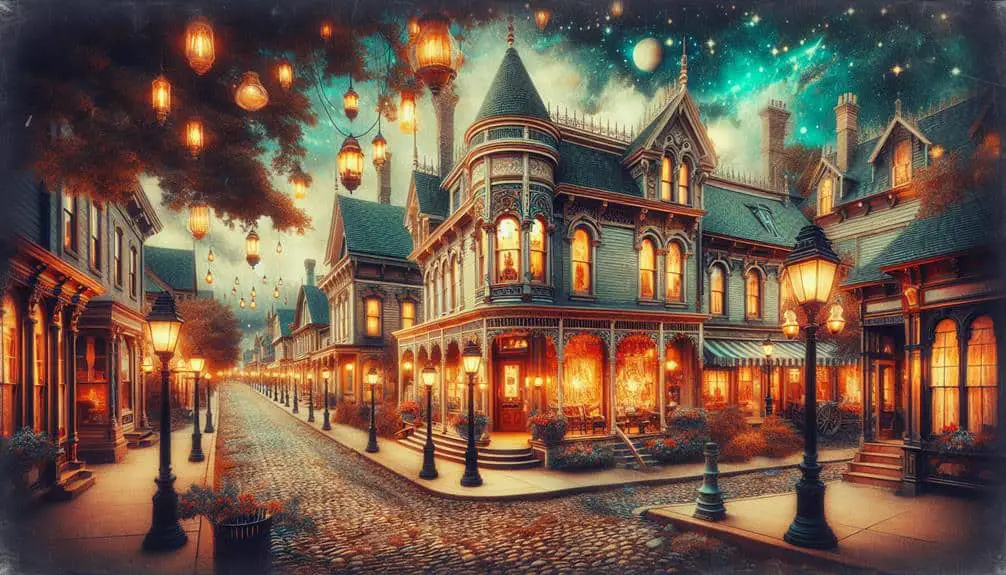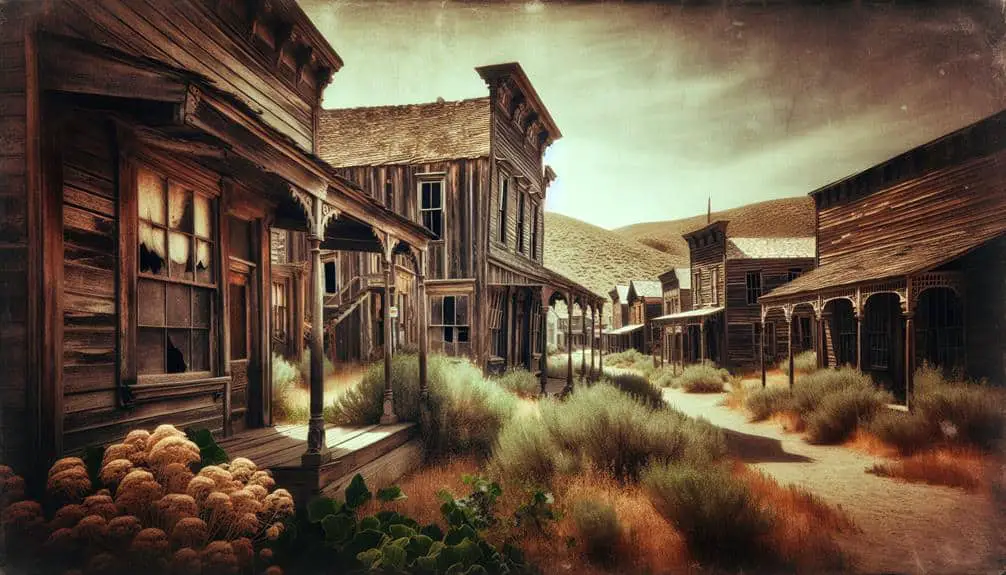Ever wondered why Victorian-era settlements in the US remain untouched? These ghost towns delicately balance historical preservation and modern development. They offer a rare glimpse into the past, frozen in time with architecture and societal norms intact. Challenges like environmental threats and funding shortages hinder maintenance efforts. Urban sprawl poses a constant threat, but these settlements hold immense cultural and architectural value. Implementing proactive conservation strategies, involving the community, and focusing on structural integrity are key. The intricate stories and unique designs of these towns await discovery. Explore their hidden treasures to uncover more about their rich history.
Key Points
- Limited economic viability for development due to remote locations or lack of infrastructure.
- Historical preservation efforts prioritize maintaining authenticity and historical integrity.
- Protection through conservation laws and regulations to safeguard heritage sites.
- Cultural significance and value as time capsules of Victorian-era architecture and lifestyle.
- Challenges in balancing preservation with modern development pressures.
Historical Significance of Victorian-Era Ghost Towns
Why do Victorian-era ghost towns hold such historical significance today?
Victorian-era ghost towns are vital for historical preservation and hold immense tourism potential. These settlements offer a glimpse into the past, showcasing the architecture, lifestyle, and societal norms of the Victorian era. By preserving these ghost towns, we can guarantee that future generations have the opportunity to understand and appreciate the history that shaped our present.
Historical preservation is at the core of why these ghost towns are significant. They serve as time capsules, freezing a moment in history for us to study and learn from. The architecture, artifacts, and overall layout of these towns provide valuable insights into how people lived during the Victorian era. By maintaining these sites, we can continue to uncover new information and enrich our understanding of the past.
Moreover, the tourism potential of Victorian-era ghost towns is undeniable. People are drawn to these sites out of curiosity and a desire to connect with history. By promoting these ghost towns as tourist destinations, we can't only educate the public about the past but also stimulate local economies and create opportunities for growth. Essentially, Victorian-era ghost towns aren't just remnants of the past; they're living lessons waiting to be explored.
Preservation Challenges Faced by Ghost Town Sites
Preservation challenges faced by ghost town sites stem from a myriad of factors, encompassing environmental decay, lack of funding, and the complexities of maintaining historical integrity. Environmental threats such as natural disasters, erosion, and vegetation overgrowth pose significant risks to these abandoned sites. Conservation efforts are vital to combat these challenges, requiring ongoing monitoring and restoration projects to preserve the authenticity of these historic locations.
Moreover, the lack of funding presents a major obstacle to the continuous upkeep of ghost town sites. Without adequate financial resources, essential maintenance tasks like structural repairs, pest control, and security measures become difficult to implement. Balancing the need for preservation with the costs involved remains a delicate issue for many of these neglected settlements.
Despite the challenges, recognizing the tourism potential and economic benefits of well-preserved ghost towns can incentivize stakeholders to invest in their conservation. By strategically promoting these sites as cultural heritage destinations, communities can tap into opportunities for sustainable development while safeguarding their historical legacy.
Impact of Urban Development on Old Settlements
Urban development exerts a significant influence on the historical fabric and character of old settlements, shaping their evolution and preservation challenges. As urban areas expand through urban sprawl, the pressure on surrounding historic Victorian-era settlements increases. The encroachment of modern infrastructure and residential developments poses a threat to the preservation of these old towns. Urban sprawl often leads to the neglect and deterioration of these settlements, as resources are diverted towards newer regions.
Additionally, gentrification plays a role in the impact on old settlements. The influx of wealthier residents into these areas can result in the restoration and revitalization of historic buildings. However, this process can also lead to the displacement of original inhabitants and changes in the cultural and socioeconomic dynamics of the settlement.
Balancing the need for urban development with the preservation of Victorian-era settlements is a delicate task. Finding ways to integrate modern amenities while respecting the historical significance of these old towns is essential for maintaining their unique charm and heritage.
Cultural and Architectural Value of Abandoned Towns
Amidst the quiet stillness of deserted towns, a profound cultural and architectural legacy silently awaits discovery and appreciation. The architectural preservation of these Victorian-era settlements provides a glimpse into the past, showcasing intricate designs, ornate details, and unique building techniques that reflect the craftsmanship of the time. Each abandoned building holds stories of the community that once thrived within its walls, waiting to be shared through community storytelling.
The cultural value of these deserted towns lies in their ability to transport visitors to a different era, offering a tangible connection to history. Exploring these ghost towns allows for a deeper understanding of the social dynamics, economic activities, and daily life of past generations. The architectural features of these settlements serve as a proof to the creativity and ingenuity of the people who inhabited them, inviting admiration and contemplation.
Preserving these deserted towns is crucial to safeguarding their cultural and architectural significance for future generations. By embracing the history embedded in these forgotten places, we can guarantee that their stories continue to be told, celebrated, and cherished.
Strategies for Protecting Victorian-Era Ghost Towns
To safeguard the cultural and architectural heritage of Victorian-era ghost towns, implementing proactive conservation strategies is essential. Community involvement plays an important role in the preservation of these historic sites. Encouraging local residents, historians, and preservationists to actively participate in conservation efforts can help guarantee the sustainability of these ghost towns. Organizing community clean-up days, fundraising events, and educational programs can foster a sense of ownership and responsibility among the residents, leading to better protection of the town's heritage.
Conservation efforts should focus on maintaining the structural integrity of buildings, restoring historical landmarks, and preventing further deterioration of the environment. Developing a detailed conservation plan that outlines specific preservation goals and strategies is crucial in guiding these efforts. Utilizing advanced technologies such as 3D scanning and digital mapping can aid in documenting and monitoring the condition of Victorian-era ghost towns.
Frequently Asked Questions
What Are Some Common Myths or Legends Associated With Victorian-Era Ghost Towns in the Us?
Step into the eerie whispers of Victorian-era ghost towns, where haunted stories intertwine with folklore. From tales of spectral apparitions to urban legends of paranormal activity, these abandoned settlements hold mysteries waiting to be unraveled.
How Do Victorian-Era Settlements Differ From Other Types of Abandoned Towns in Terms of Preservation Challenges?
In preserving Victorian-era settlements, unique challenges arise due to their historical significance. These towns require specialized care to maintain their authenticity. Understanding these preservation challenges is important to safeguarding our past for future generations.
Are There Any Notable Examples of Victorian-Era Ghost Towns That Have Been Successfully Incorporated Into Modern Urban Development?
Looking to revitalize urban areas? Victorian-era ghost towns offer renovation opportunities for historical preservation and economic growth. Examples like Centralia, PA, showcase successful incorporation into modern development, blending history with progress.
What Role Do Victorian-Era Ghost Towns Play in Preserving the Cultural Heritage and Architectural History of the Us?
Preservation efforts for Victorian-era ghost towns in the US are crucial in safeguarding cultural significance. They serve as time capsules preserving architectural history, showcasing a glimpse of the past that contributes to the rich heritage of the nation.
How Do Strategies for Protecting Victorian-Era Ghost Towns Differ From Those Used for More Recent Abandoned Settlements?
In safeguarding Victorian-era ghost towns, traditional preservation methods meld with modern innovation. Historical significance is honored through community-driven initiatives and tourist engagement. Contrasting recent settlements, these strategies evoke a timeless charm and communal bond.



